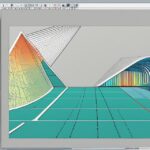Table of Contents
The history of graphic design software is rich and complex, spanning several decades of innovation and technological advancements. From its humble beginnings in the 1970s to the cutting-edge software of today, the evolution of graphic design software has revolutionized the way we create and communicate visually.
Companies like Adobe, Aldus, Altsys, Macromedia, Quark, and Xerox PARC played pivotal roles in shaping the graphic design software landscape. They introduced groundbreaking software such as PageMaker, Illustrator, FreeHand, and Dreamweaver, which laid the foundation for the industry as we know it today.
Over the years, the industry has witnessed significant shifts, including the rise of image editing programs, the advent of desktop publishing software, and the introduction of the Adobe Creative Suite. We have also seen the decline of Flash and the emergence of exciting technologies like augmented reality, virtual reality, and the Internet of Things that are poised to transform the graphic design industry once again.
In this article, we will explore the major players in graphic design software, the big shifts that have shaped the industry, the influences and styles that have influenced design throughout the decades, as well as the recent changes and future trends we can expect in graphic design.
Major Players in Graphic Design Software
When it comes to graphic design software, Adobe Systems has emerged as the dominant player in the industry. However, it’s important to recognize that Adobe wasn’t always the only major player in this field. Other companies like Aldus, Altsys, Macromedia, Quark, and Xerox PARC have also made significant contributions to the evolution of graphic design software.
Aldus Corporation, for instance, developed the groundbreaking software PageMaker, which revolutionized desktop publishing. Altsys Corporation provided tough competition to Adobe Illustrator with its software FreeHand, offering designers an alternative option.
Macromedia, on the other hand, created pioneering applications like Dreamweaver, Shockwave, and Director, which expanded the possibilities for interactive and multimedia design. Quark gained popularity in the 1990s with its WYSIWYG desktop publishing software QuarkXPress, serving as a direct competitor to Adobe’s products.
Lastly, Xerox PARC played a foundational role by introducing innovative concepts such as the graphical user interface (GUI), WYSIWYG text editing, and the computer mouse, all of which have become integral parts of modern graphic design.
While many of these major players have either disappeared or been acquired by other companies, Adobe continues to dominate the graphic design software industry. Let’s take a closer look at the contributions of these major players in the table below:
| Company | Software |
|---|---|
| Aldus | PageMaker |
| Altsys | FreeHand |
| Macromedia | Dreamweaver, Shockwave, Director |
| Quark | QuarkXPress |
| Xerox PARC | GUI, WYSIWYG text editing, computer mouse |
This table showcases the major players in graphic design software and the significant contributions made by each company in shaping the industry.
The Big Shifts in the Evolution of Graphic Design Programs
The evolution of graphic design programs has witnessed significant shifts propelled by advancements in technology and changing design trends. Throughout the years, these shifts have shaped the landscape of graphic design, revolutionizing the way designers work and pushing creative boundaries.
Image Editing Programs: SuperPaint and Beyond
One of the earliest milestones in the evolution of graphic design programs was the introduction of SuperPaint in 1973. SuperPaint, a groundbreaking image editing program, allowed designers to manipulate and modify images digitally for the first time. This marked a significant shift from traditional manual methods, bringing greater efficiency and creativity to the graphic design process.
Following the success of SuperPaint, the introduction of Apple’s Macintosh in 1984 paved the way for a new era of graphic design programs. It brought forth a wave of revolutionary software such as PageMaker, Illustrator, FreeHand, and Photoshop. These programs offered designers unprecedented control and versatility, enabling them to create visually stunning designs with ease.
The Rise and Fall of Flash
In the 1990s, Flash emerged as a breakthrough technology, allowing designers to create interactive and animated content for the web. Flash quickly gained popularity and became an integral part of websites, providing immersive user experiences. However, with the rise of mobile devices and the emergence of alternative web technologies, Flash began to lose its dominance.
Adobe, the creator of Flash, announced its plans to retire the technology in 2017. This marked the end of an era, as Flash was replaced by more versatile and lightweight alternatives such as HTML5 and CSS3. The fall of Flash symbolizes the ever-changing nature of graphic design programs and the need for designers to adapt to new technologies and trends.
The Adobe Creative Suite: Empowering Designers
The 2000s witnessed a major milestone in the graphic design industry with the introduction of the Adobe Creative Suite. The Adobe Creative Suite revolutionized the way designers work by integrating various design software into a single, cohesive platform. Designers gained access to a comprehensive suite of tools, including Photoshop, Illustrator, InDesign, and more, empowering them to bring their creative visions to life.
Today, graphic design technology is on the brink of yet another transformation. With the rise of augmented reality, virtual reality, smartphones, and the promise of 5G and the Internet of Things, the future of graphic design holds great potential for innovative advancements and limitless creative possibilities.
Key takeaways:
- The development of image editing programs like SuperPaint revolutionized the graphic design process.
- The rise and fall of Flash showcased the ever-changing nature of graphic design programs.
- The Adobe Creative Suite empowered designers with a comprehensive suite of tools.
- The evolving landscape of graphic design technology holds great promise for future innovations.
Influences and Styles in Graphic Design Throughout the Decades
Graphic design has been influenced by various factors throughout the decades. In the early days, typography for books and newspapers and cave paintings represented forms of graphic design. The 1960s saw the influence of television advertising and political protests on poster art. The 1970s brought influences from Japanese art and a focus on symmetry, colours, and icons. The 1980s were characterised by bold, bright colours and the democratization of design tools with the advent of personal computers. The 1990s witnessed the rise of digital art with the introduction of Photoshop and the emergence of the grunge style. The 2000s brought about new possibilities with advanced design tools and a focus on movement and interaction. Contemporary graphic design encompasses a mix of techniques and styles, with trends emerging year to year.
Typography and Poster Art in the 1960s
The 1960s marked a significant period for graphic design, with typography and poster art greatly influenced by the cultural and political movements of the time. This era saw a rise in experimental typography, as designers explored new forms and layouts. Poster art embraced bold colours, striking typography, and expressive imagery to convey powerful messages.
“Design is thinking made visual.” – Saul Bass, American graphic designer
Influences from Japanese Art in the 1970s
In the 1970s, graphic design was heavily influenced by Japanese art. Designers drew inspiration from traditional Japanese aesthetics, such as simplicity, asymmetry, and natural elements. The use of vibrant colours and intricate patterns became common in graphic design during this period. The focus on symmetry, colours, and icons contributed to the development of a clean and harmonious visual language.
Bold Colors and the Democratization of Design Tools in the 1980s
The 1980s witnessed a surge in bold, bright colours in graphic design. This era marked the democratization of design tools with the introduction of personal computers and software like Adobe Illustrator and Photoshop. Designers had more control over their creative process, and vibrant colours became a defining characteristic of graphic design in the 1980s.
The Rise of Digital Art and the Emergence of Grunge Style in the 1990s
The 1990s brought about a revolution in graphic design with the rise of digital art. The introduction of software like Photoshop allowed designers to manipulate images and create surreal compositions. This decade also saw the emergence of the grunge style, characterized by its distressed and raw aesthetic. Grunge-style typography and graphics became popular in album covers, magazines, and posters.
Advanced Design Tools and Focus on Movement and Interaction in the 2000s
The 2000s ushered in advanced design tools, enabling designers to create dynamic and interactive designs. With the advent of technologies like Flash, designers could incorporate movement and animation into their work. This era saw an emphasis on user experience and interface design, as websites and digital platforms became more prevalent.
| Decade | Influences | Styles |
|---|---|---|
| 1960s | Television advertising, political protests | Bold typography, expressive imagery |
| 1970s | Japanese art | Vibrant colours, symmetry, icons |
| 1980s | Democratization of design tools | Bold, bright colours |
| 1990s | Digital art | Grunge style, distressed aesthetic |
| 2000s | Advanced design tools | Movement, animation, user experience |
Recent Changes and Future Trends in Graphic Design
Over the past few years, the field of graphic design has experienced significant transformations, driven by technological advancements and evolving user preferences. From innovative design trends to the ever-growing importance of user experience, the graphic design landscape is constantly evolving.
The Changing Face of Graphic Design
One notable change in recent years is the adoption of new design trends. Cutout text, which involves using bold typography with cut-out shapes and images, has gained popularity for its visually striking effect. This trend adds depth and dimension to designs, making them more engaging for viewers.
Strong images have also become a prevalent feature in modern graphic design. High-quality visuals can captivate audiences and convey a brand’s message more effectively. Designers are now investing time and effort into selecting and creating impactful imagery that resonates with their target audience.
Flat icons have emerged as a prominent design element, moving away from complicated, skeuomorphic designs to simpler and more minimalistic styles. This clean and straightforward approach allows for better readability and scalability, ensuring that icons and graphics remain visually appealing across different platforms and devices.
Videos have also gained traction in graphic design, with the rise of interactive and immersive experiences. Incorporating videos can bring designs to life and create a more dynamic and engaging user experience.
Future Trends in Graphic Design
Looking ahead, the future of graphic design holds exciting possibilities. Improved mobile usability will continue to be a prominent trend as mobile devices dominate the digital landscape. Designers will focus on creating designs that are not only visually appealing on smaller screens but also provide seamless interactions across multiple devices.
The blending of design and animation is another anticipated trend. Animation adds a layer of interactivity and enhances user engagement. As technology advances, we can expect to see more captivating and sophisticated animations integrated into graphic design.
While software costs may increase, the industry will witness more powerful and feature-rich graphic design tools. These advanced tools will enable designers to push boundaries and create groundbreaking visuals.
Personalized designs are expected to play a significant role in the future of graphic design. With data-driven insights and user research, designers can tailor their designs to individual users, providing a more personalized and tailored experience.
Lastly, user experience will remain a top priority for designers. Creating designs that are intuitive, accessible, and user-friendly will be essential as the digital landscape continues to evolve.
Future Trends in Graphic Design
“Design is not just what it looks like and feels like. Design is how it works.” – Steve Jobs
As Steve Jobs famously said, design is not solely about aesthetics but also about functionality. The future of graphic design holds the promise of seamlessly integrating form and function to create visually stunning and user-centered designs.
To summarize, recent changes in graphic design have seen the adoption of bold design trends such as cutout text, strong images, flat icons, and videos. Looking ahead, future trends in graphic design point towards improved mobile usability, the blending of design and animation, more powerful software, personalized designs, and a continued focus on enhancing the user experience.
| Trends | Description |
|---|---|
| Cutout Text | Visually striking typography with cut-out shapes and images |
| Strong Images | High-quality visuals that captivate audiences |
| Flat Icons | Simpler and minimalistic design elements for better scalability |
| Videos | Interactive and immersive experiences |
| Improved Mobile Usability | Designs optimized for seamless mobile interactions |
| Blending of Design and Animation | Integration of animated elements for enhanced user engagement |
| More Powerful Software | Advanced tools enabling groundbreaking visuals |
| Personalized Designs | Tailored designs based on user data and research |
| User Experience | Continued focus on intuitive and user-friendly designs |
Conclusion
The evolution of graphic design software over the decades has been a dynamic process, shaped by major players, advancements in technology, and changing trends. From the early days of hand-drawn designs to the digital revolution, graphic design has come a long way.
As technology continues to evolve and new trends emerge, the future of graphic design looks promising. With an emphasis on user experience, personalized designs, and interactivity, the graphic design industry is poised for further growth and innovation.
While specific trends may change, the fundamental principles of creating visually captivating and compelling designs will remain at the core of graphic design. Designers need to stay abreast of the latest graphic design trends and adapt to the ever-changing landscape in order to meet the needs and expectations of their clients.
FAQ
What is the history of graphic design software?
The history of graphic design software dates back to the 1970s when major players like Adobe, Aldus, Altsys, Macromedia, Quark, and Xerox PARC emerged. These companies developed groundbreaking software such as PageMaker, Illustrator, FreeHand, and Dreamweaver.
Who are the major players in graphic design software?
The major players in graphic design software include Adobe Systems, Aldus, Altsys, Macromedia, Quark, and Xerox PARC. Adobe, in particular, has emerged as the dominant player in the industry.
What are the big shifts in the evolution of graphic design programs?
The big shifts in the evolution of graphic design programs include the development of image editing programs like SuperPaint, the release of the Adobe Creative Suite, and the rise and fall of Flash.
What are the influences and styles in graphic design throughout the decades?
Graphic design has been influenced by various factors throughout the decades, including typography, television advertising, Japanese art, bold colors, and digital art styles like grunge.
What are the recent changes and future trends in graphic design?
Recent changes in graphic design include the focus on mobile workability, multi-device compatibility, personalized and interactive designs, and an emphasis on user experience. Future trends may include improved mobile usability, the blending of design and animation, and more expensive software.
What is the future of graphic design?
The future of graphic design is uncertain, but trends such as improved mobile usability, personalized designs, and immersive experiences are predicted. The user experience will continue to be a priority in the industry.













